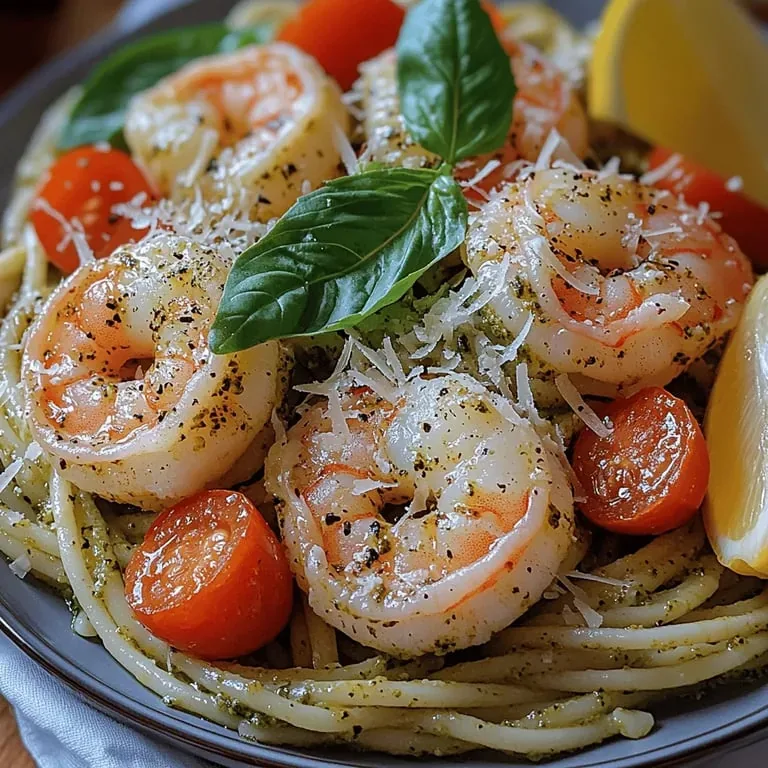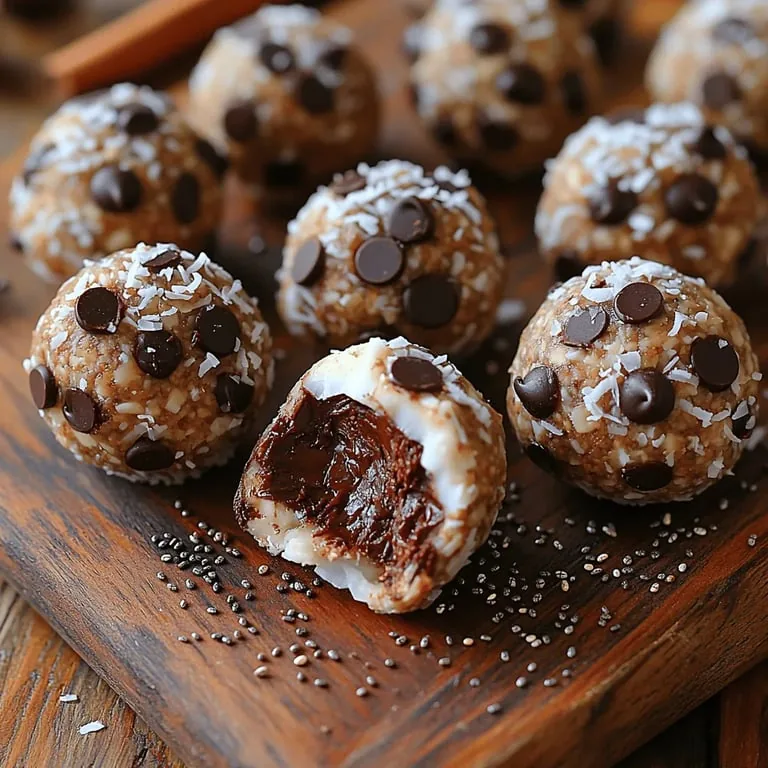Imagine the aroma of fresh basil swirling with the sweet scent of sautéed shrimp, all tangled in a silky strand of al dente pasta. That’s the magic behind Pesto Shrimp Pasta Delight: A Flavorful Journey. This dish captures the bright, herbaceous punch of classic pesto while letting succulent shrimp take center stage.
What makes this recipe truly special is the balance between the nutty richness of pine nuts, the sharp bite of Parmesan, and the citrusy lift from lemon zest. Each forkful delivers a burst of Mediterranean sunshine, making it unforgettable.
Seafood lovers, pasta enthusiasts, and anyone craving a quick yet impressive dinner will adore this meal. It shines at weeknight family tables, casual gatherings, or even a relaxed weekend brunch.
The cooking process is straightforward: while the pasta boils, you’ll blend a fresh pesto, quickly sear the shrimp, then toss everything together in a pan, allowing the sauce to cling lovingly to every strand. In under thirty minutes, you’ll have a restaurant‑quality plate ready to serve.
Why You'll Love This Recipe
Bright, Herb‑Forward Flavor: The homemade pesto delivers a fresh, garden‑like brightness that lifts the shrimp and pasta, creating a harmonious, uplifting taste experience.
Quick Weeknight Solution: From start to finish it takes less than thirty minutes, making it perfect for busy evenings without sacrificing depth of flavor.
Visually Stunning Plate: The vivid green pesto, pink shrimp, and golden pasta create a colorful presentation that looks as good as it tastes.
Nutritious & Satisfying: Packed with lean protein, healthy fats from olive oil and nuts, and antioxidant‑rich basil, this dish fuels body and soul alike.
Ingredients
The heart of this dish lies in fresh, high‑quality components. Plump shrimp provide a sweet, briny base, while the pasta offers a neutral canvas for the sauce. The pesto—made from basil, pine nuts, Parmesan, garlic, and olive oil—brings herbaceous richness, and a splash of lemon adds a lively contrast. Together they create a balanced, mouth‑watering experience.
Main Ingredients
- 12 oz (340 g) linguine or fettuccine
- 1 lb (450 g) large shrimp, peeled and deveined
Pesto Sauce
- 2 cups packed fresh basil leaves
- ¼ cup pine nuts, lightly toasted
- ½ cup grated Parmesan cheese
- 2 cloves garlic, minced
- ⅓ cup extra‑virgin olive oil
- 1 tablespoon fresh lemon zest
Seasonings & Garnish
- ½ teaspoon red‑pepper flakes (optional)
- Salt and freshly ground black pepper, to taste
- 2 tablespoons unsalted butter
- Freshly grated Parmesan, for serving
- Extra basil leaves, for garnish
These ingredients work together to create a layered flavor profile. The toasted pine nuts add a buttery crunch, while the Parmesan contributes umami depth. Garlic and lemon zest brighten the pesto, preventing it from feeling heavy. The butter finishes the sauce with a velvety sheen, and the red‑pepper flakes offer a subtle heat that can be adjusted to taste.
Step-by-Step Instructions

Preparing the Pasta
Bring a large pot of salted water to a rolling boil. Add the linguine and cook according to package directions until al dente, usually 9–11 minutes. Reserve ½ cup of the starchy cooking water before draining; this liquid will help emulsify the pesto later, ensuring a silky coating.
Making the Pesto
- Blend the herbs. In a food processor, combine fresh basil, toasted pine nuts, minced garlic, and a pinch of salt. Pulse until coarsely chopped, releasing the basil’s bright aroma.
- Incorporate cheese. Add the Parmesan and pulse a few more times. The cheese thickens the sauce and adds a salty, nutty dimension.
- Emulsify with oil. With the processor running, slowly drizzle in the olive oil. The gradual addition creates a smooth, glossy emulsion. Finish by folding in the lemon zest for a citrus lift.
Cooking the Shrimp
- Season the shrimp. Pat the shrimp dry with paper towels, then sprinkle with salt, black pepper, and red‑pepper flakes if using. This dry surface promotes a quick, caramelized sear.
- Sauté quickly. Heat a large skillet over medium‑high heat, melt 2 Tbsp butter, and add the shrimp in a single layer. Cook 1–2 minutes per side until they turn pink and opaque. Avoid overcooking; shrimp become rubbery past 3 minutes per side.
- Deglaze. Remove the shrimp and set aside. Add a splash of the reserved pasta water to the pan, scraping up any browned bits. This creates a light broth that will later blend with the pesto.
Bringing It All Together
Return the cooked linguine to the skillet with the deglazed broth. Toss to coat, then add the prepared pesto and the reserved pasta water a tablespoon at a time, stirring until the sauce clings to each strand. Gently fold the sautéed shrimp back in, allowing the heat to re‑warm them for about a minute. Finish with a drizzle of extra‑virgin olive oil and a sprinkle of fresh basil leaves and grated Parmesan. Serve immediately while the sauce is glossy and the shrimp are tender.
Tips & Tricks
Perfecting the Recipe
Use ice‑water for shrimp. After thawing, rinse shrimp in ice‑cold water and pat dry. This removes excess moisture, ensuring a quick sear and preventing sogginess.
Reserve pasta water early. The starchy water is essential for emulsifying the pesto; add it gradually to achieve the perfect sauce consistency.
Toast pine nuts lightly. A minute or two in a dry skillet brings out a nutty aroma without burning, elevating the pesto’s flavor profile.
Flavor Enhancements
Add a splash of white wine to the pan after sautéing the shrimp; let it reduce before deglazing for an extra layer of depth. Finish the dish with a squeeze of fresh lemon juice right before serving to brighten the pesto and balance the richness.
Common Mistakes to Avoid
Do not over‑cook the shrimp—once they turn pink, they’re done. Overcooking makes them tough. Also, avoid adding the pesto to boiling pasta; the heat should be gentle to preserve the fresh basil flavor.
Pro Tips
Blend in batches. If your processor is small, pulse the pesto ingredients in two batches to ensure even blending and prevent overheating.
Season at each stage. Lightly salt the pasta water, the shrimp, and the pesto. Layered seasoning builds depth without relying on a single salt hit.
Use a high‑quality olive oil. A robust, cold‑pressed olive oil adds fruitiness that pairs beautifully with basil and shrimp.
Variations
Ingredient Swaps
Replace shrimp with scallops or bite‑size chicken for a different protein. Swap pine nuts for walnuts or almonds if you prefer a milder nut flavor. For a dairy‑free pesto, use nutritional yeast instead of Parmesan and a splash of avocado oil.
Dietary Adjustments
Choose gluten‑free pasta made from rice or corn to keep the dish safe for gluten sensitivities. To make it keto‑friendly, substitute pasta with zucchini noodles (zoodles) and use a sugar‑free sweetener if you add a hint of honey. For vegans, replace shrimp with marinated tofu and use a vegan Parmesan alternative.
Serving Suggestions
Pair the pasta with a crisp arugula salad dressed in lemon vinaigrette, or serve alongside roasted asparagus for added texture. A side of garlic‑toasted baguette is perfect for mopping up any extra pesto sauce.
Storage Info
Leftover Storage
Allow the dish to cool to room temperature, then transfer to an airtight container. Store in the refrigerator for up to 3 days. For longer keep, portion into freezer‑safe bags, squeeze out excess air, and freeze for up to 2 months. The pesto may darken slightly but will retain flavor.
Reheating Instructions
Reheat gently in a skillet over low heat, adding a tablespoon of water or broth to revive the sauce’s silkiness. Alternatively, microwave in a covered dish on medium power for 2–3 minutes, stirring halfway through. Finish with a fresh drizzle of olive oil and a sprinkle of Parmesan to restore brightness.
Frequently Asked Questions
This Pesto Shrimp Pasta Delight brings together bright herbaceous pesto, succulent shrimp, and perfectly cooked pasta in a single, satisfying dish. By following the step‑by‑step guide, mastering the quick sear, and using the tips for emulsifying the sauce, you’ll achieve restaurant‑level flavor at home. Feel free to experiment with the suggested swaps or dietary tweaks—cooking is a personal adventure. Serve it hot, share it with loved ones, and enjoy every aromatic bite!











